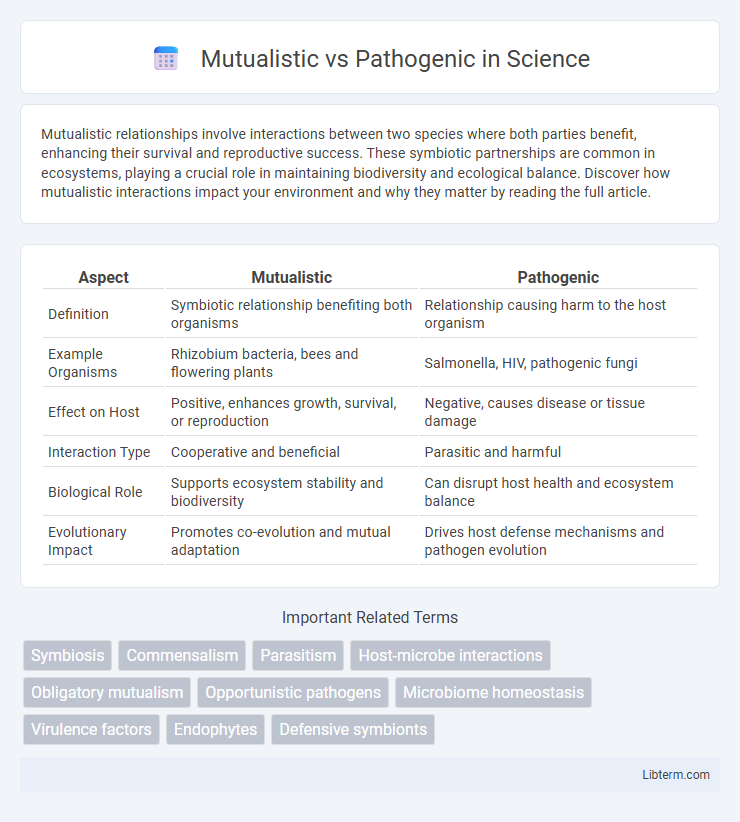Mutualistic relationships involve interactions between two species where both parties benefit, enhancing their survival and reproductive success. These symbiotic partnerships are common in ecosystems, playing a crucial role in maintaining biodiversity and ecological balance. Discover how mutualistic interactions impact your environment and why they matter by reading the full article.
Table of Comparison
| Aspect | Mutualistic | Pathogenic |
|---|---|---|
| Definition | Symbiotic relationship benefiting both organisms | Relationship causing harm to the host organism |
| Example Organisms | Rhizobium bacteria, bees and flowering plants | Salmonella, HIV, pathogenic fungi |
| Effect on Host | Positive, enhances growth, survival, or reproduction | Negative, causes disease or tissue damage |
| Interaction Type | Cooperative and beneficial | Parasitic and harmful |
| Biological Role | Supports ecosystem stability and biodiversity | Can disrupt host health and ecosystem balance |
| Evolutionary Impact | Promotes co-evolution and mutual adaptation | Drives host defense mechanisms and pathogen evolution |
Introduction to Microbial Relationships
Mutualistic microbial relationships involve symbiotic interactions where both the microbe and host benefit, such as gut bacteria aiding in digestion and vitamin production. Pathogenic relationships occur when microbes invade and harm the host, causing diseases like tuberculosis or strep throat. Understanding these contrasting interactions provides insight into microbial roles in health and disease dynamics.
Defining Mutualism and Pathogenicity
Mutualism is a symbiotic relationship where both organisms involved benefit, such as bees pollinating flowers while obtaining nectar. Pathogenicity refers to an organism's ability to cause disease in a host, often leading to harm or dysfunction, exemplified by bacteria like Salmonella infecting the human gut. Understanding these definitions is crucial for studying ecological interactions and managing health in agricultural or medical contexts.
Key Differences Between Mutualistic and Pathogenic Interactions
Mutualistic interactions involve a symbiotic relationship where both organisms benefit, such as the nitrogen-fixing bacteria in plant roots that enhance nutrient uptake and plant growth. Pathogenic interactions result in harm to the host, exemplified by bacteria like Streptococcus pyogenes causing diseases such as strep throat and tissue damage. Key differences include the outcome for the host--beneficial in mutualism versus harmful in pathogenic cases--and the evolutionary adaptations that promote cooperation in mutualism versus mechanisms for invasion and evasion of host defenses in pathogens.
Mutualistic Relationships: Examples and Benefits
Mutualistic relationships involve interactions where both species benefit, such as the symbiosis between bees and flowering plants, where bees obtain nectar while facilitating pollination. Another example includes the gut microbiota in humans, which aids digestion and supports immune function. These relationships enhance biodiversity, ecosystem stability, and species survival through cooperative resource exchange and mutual support.
Pathogenic Interactions: Mechanisms and Impact
Pathogenic interactions involve microorganisms such as bacteria, viruses, and fungi invading host organisms and triggering disease through mechanisms like toxin production, immune system evasion, and tissue damage. These pathogens utilize specialized molecules called effectors to manipulate host cellular processes, suppress immune responses, and facilitate infection. The impact of pathogenic interactions includes host morbidity and mortality, disruption of ecosystems, and significant economic losses in agriculture and healthcare sectors.
Host Adaptations to Mutualists and Pathogens
Hosts develop specialized immune mechanisms to tolerate mutualistic microbes while effectively defending against pathogenic invasions, balancing immune responses to maintain beneficial symbiosis. Structural adaptations such as mucosal barriers and antimicrobial peptides selectively inhibit pathogens without harming mutualistic communities. Genetic regulation fine-tunes host immune signaling pathways, promoting mutualist colonization and suppressing pathogen virulence factors for optimized host survival and health.
Shifts Between Mutualism and Pathogenicity
Shifts between mutualism and pathogenicity occur when microorganisms alter their relationship with the host based on environmental conditions or genetic changes, leading to a transition from beneficial symbiosis to harmful infection or vice versa. These dynamic interactions are influenced by factors such as host immune response, microbial gene expression, and resource availability, impacting disease development and host health. Understanding these shifts is crucial for developing targeted therapies and managing microbiome-related diseases.
Ecological and Evolutionary Implications
Mutualistic relationships enhance ecosystem stability by promoting biodiversity and resource sharing, driving coevolutionary adaptations that increase species fitness. Pathogenic interactions often lead to selective pressure on host defense mechanisms, shaping evolutionary arms races and influencing population dynamics. Both mutualism and pathogenicity critically affect ecological community structure and evolutionary trajectories by modulating species interactions and genetic variation.
Human Health: Harnessing Mutualists, Combating Pathogens
Mutualistic microbes in the human microbiome enhance immune function, aid digestion, and produce essential vitamins, thereby promoting overall health and preventing disease. Pathogenic microorganisms, however, disrupt homeostasis by causing infections and triggering inflammatory responses that can lead to chronic illnesses. Targeted therapies harness beneficial mutualists through probiotics and prebiotics while employing antibiotics and immunotherapies to combat harmful pathogens effectively.
Future Directions in Studying Microbial Relationships
Future research in microbial relationships emphasizes advanced genomic and metagenomic techniques to unravel the complex interactions between mutualistic and pathogenic microbes. Integrating machine learning models with high-throughput sequencing data will enhance predictions of microbial behavior in diverse environments. Exploring synthetic biology approaches promises to engineer beneficial microbes for health and agriculture, while mitigating pathogen impacts through targeted interventions.
Mutualistic Infographic

 libterm.com
libterm.com